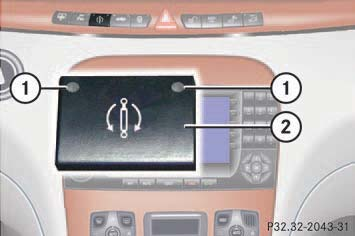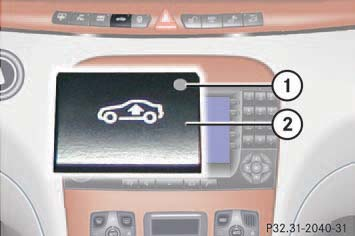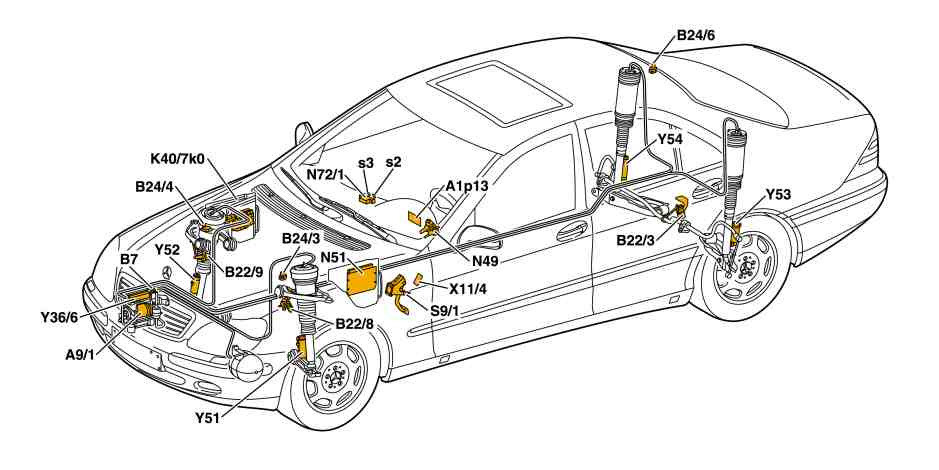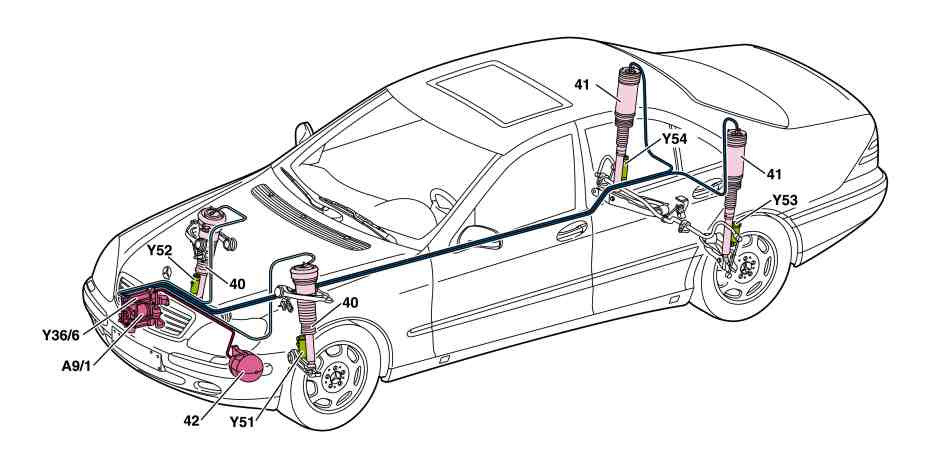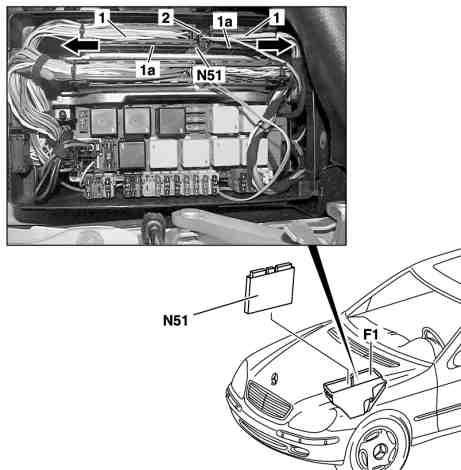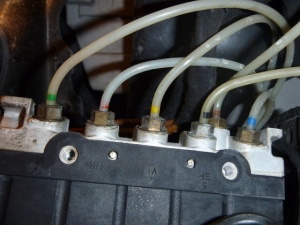Airmatic: Difference between revisions
Ricebubbles (talk | contribs) |
(added information about some components) |
||
| Line 49: | Line 49: | ||
* Switch indicator lamps | * Switch indicator lamps | ||
* Air compressor | * Air compressor | ||
==Adaptive Damping System (ADS)== | |||
<!-- operator's manual 2004 --> | |||
The switch with the indicator lamps is located in the upper part of the center console. | |||
[[File:W220_damping_switch.png]] | |||
The ADS automatically selects the optimum damping for the respective driving conditions. At the same time the suspension is set to either sporty or regular. | |||
The suspension tuning is set according to: | |||
* Your driving style | |||
* Road surface conditions | |||
* Your choice of suspension style, "sport" or "convenience", which you select using the damping switch. | |||
The following suspension styles are available: | |||
* "Convenience" - both indicator lamps (1) are off. | |||
* "Sports 1" - one indicator lamp (1) is on. | |||
* "Sports 2" - both indicator lamps (1) are on. | |||
The selected suspension style is stored in memory, even after the SmartKey is removed from the starter switch. | |||
==Level control system== | |||
<!-- operator's manual 2004 --> | |||
[[File:W220_vehicle_level_control_switch.png]] | |||
The following vehicle level settings can be selected when the vehicle is stationary: | |||
* "Normal" - for driving on normal roads. The indicator lamp (1) is off. | |||
* "Raised" - for driving on rough roads or with snow chains. The indicator lamp (1) is on. | |||
Select the "Raised" level setting only when required by current driving conditions. Otherwise the fuel consumption may increase and handling may be impaired. | |||
The vehicle chassis ride height is raised or lowered according to the selected level setting and to the vehicle speed | |||
(these height adjustments are so small that you may not notice any change): | |||
* With increasing speed, ride height is reduced by up to approximately 3/4 in (20 mm). | |||
* With decreasing speed, the ride height is again raised to the selected vehicle level. | |||
The selected vehicle level setting remains stored in memory even if the engine is turned off and restarted. However, the vehicle lowers to regular level when you exceed a speed of 75 mph (120 km/h) or maintain a speed of between 50 mph (80 km/h) and 75 mph (120 km/h) for more than 5 minutes. | |||
<!-- WIS GF32.22-P-0003-01B --> | |||
This can be used to raise the vehicle level by 25 mm (20 mm USA). | |||
The raised level switch position is indicated by the red indicator lamp (1) in the switch. | |||
In addition, the multifunction display in the instrument cluster displays: "AIRMATIC VEHICLE RISING". | |||
As long as the multifunction display in the instrument cluster shows the message: "AIRMATIC VEHICLE RISING", | |||
the desired vehicle level has not yet been reached. | |||
If the raising of the vehicle is cancelled due to the driving speed, | |||
the instrument cluster displays the following message for approx. 10s: "AIRMATIC LEVEL SETTING CANCELLED". | |||
If the vehicle is raised several times in quick succession, it may happen that the air compressor shuts down | |||
temporarily in order to prevent an overload. The raising sequence will then take an unusually long time. | |||
== Components == | |||
<!-- WIS GF32.22-P-0003-03A --> | |||
[[File:W220_airmatic_location_of_electrical_electronic_components.jpg]] | |||
AIRmatic, location of electrical/electronic components: | |||
* A9/1 - AIRmatic compressor unit | |||
* A1p13 - Multifunction display | |||
* B7 - AIRmatic pressure sensor | |||
* B22/3 - Rear axle level sensor | |||
* B22/8 - Left front level sensor | |||
* B22/9 - Right front level sensor | |||
* B24/3 - Left front body acceleration sensor | |||
* B24/4 - Right front body acceleration sensor | |||
* B24/6 - Right rear body acceleration sensor | |||
* K40/7 - Right front fuse and relay module | |||
* kO - AIRmatic compressor relay | |||
* N49 - Steering angle sensor | |||
* N51 - AIRmatic with ADS control module | |||
* N72/1s2 - Level control switch | |||
* N72/1s3 - Comfort and sport switch | |||
* S9/1 - Stop lamp switch | |||
* X11/4 - Data link connector | |||
* Y36/6 - Level control valve unit | |||
* Y51 - Left front axle damping valve unit | |||
* Y52 - Right front axle damping valve unit | |||
* Y53 - Left rear axle damping valve unit | |||
* Y54 - Right rear axle damping valve unit | |||
<!-- GF32.22-P-0003-02A --> | |||
[[File:W220_airmatic_location_of_pneumatic_hydraulic_components.jpg]] | |||
AIRmatic, location of pneumatic/hydraulic components: | |||
* 40 - Front spring strut | |||
* 41 - Rear spring strut | |||
* 42 - AIRmatic central reservoir | |||
* A9/1 - AIRmatic compressor unit | |||
* Y36/6 - Level control valve unit | |||
* Y51 - Left front axle damping valve unit | |||
* Y52 - Right front axle damping valve unit | |||
* Y53 - Left rear axle damping valve unit | |||
* Y54 - Right rear axle damping valve unit | |||
=== AIRmatic with ADS control module (N51) === | |||
AIRmatic with ADS control module, task: To execute all control functions of ADS and AIRmatic. | |||
<!-- WIS AR32.22-P-6000I --> | |||
Air suspension control unit is located in left fuse box. | |||
[[File:W220_air_suspension_control_unit.jpg]] | |||
{| | |||
|[[File:W220_air_control_module_connectors_removed.jpg|300px]] | |||
|[[File:W220_air_control_module_removed.jpg|300px]] | |||
|} | |||
=== Level control valve unit (Y36/6) === | |||
[[File:W220_valve_block_colored.jpg|300px]] | |||
=== Damping valve unit (Y51, Y52, Y53, Y54) === | |||
<!-- WIS GF32.31-P-4300B --> | |||
Damping valve, task: adapts the damping force to the driving style and road condition. | |||
{| | |||
|[[File:W220_left_rear_axle_damping_valve.jpg|thumb|none|Y53 Left rear axle damping valve.]] | |||
<!-- WIS GF32.31-P-4300-03B --> | |||
|[[File:W220_left_front_axle_damper_valve.png|thumb|none|Y51 Left front axle damper valve (mirror image for Y52).]] | |||
|[[File:W220_left_rear_axle_damper_valve.png|thumb|none|Y53 Left rear axle damper valve (mirror image for Y54).]] | |||
|} | |||
=== Multifunction display (A1p13) === | |||
Various messages concerning the AIRmatic and ADS are shown in the multifunction display in the instrument cluster and in the comfort and sport and level adjustment switches. | |||
==== AIRMATIC VISIT WORKSHOP!==== | |||
[[File:W220_Warning_Airmatic_Visit_Workshop.jpg|thumb|none|"AIRMATIC VISIT WORKSHOP!" warning on the instrument cluster.]] | |||
<!-- WIS GF32.22-P-0003-01B --> | |||
In the event of electrical faults in the AIRmatic or ADS system, the following message appears on the | |||
multifunction display in the instrument cluster: "AIRMATIC VISIT WORKSHOP!". | |||
The fault is stored in the ADS suspension control module and can be read out using the diagnosis tool. | |||
'''Limp-home function''' | |||
A malfunction in the adaptive damping system causes the ADS to shut down. | |||
The suspension is switched to the hardest setting. | |||
In the event of a fault in the suspension system or in the level adjustment system, | |||
the vehicle attempts to maintain the set level. | |||
Manual and automatic level adjustments are no longer possible. | |||
====AIRMATIC STOP, CAR TOO LOW!==== | |||
[[File:W220_Warning_Stop_Car_Too_Low.jpg|thumb|none|"AIRMATIC STOP, CAR TOO LOW!" warning on the instrument cluster.]] | |||
<!-- WIS GF32.22-P-0003-01B --> | |||
If the vehicle level at the front axle is more than 50 mm (60 mm USA), or at the rear axle more than 60 mm (70 mm USA) | |||
below the normal level, the multifunction display in the instrument cluster displays the warning: | |||
"AIRMATIC STOP, CAR TOO LOW!". The display disappears again when the level has risen back to 48 mm or 58 mm | |||
(58 mm or 68 mm USA) respectively below the normal level. | |||
==Emergency Procedure - Airmatic== | ==Emergency Procedure - Airmatic== | ||
Revision as of 22:07, 23 March 2015
Description - WIS 32.22 Air Suspension / Airmatic
The W220 Airmatic system is a fully supporting air suspension system which provides both static and dynamic support by means of four air bellows located at the wheels.
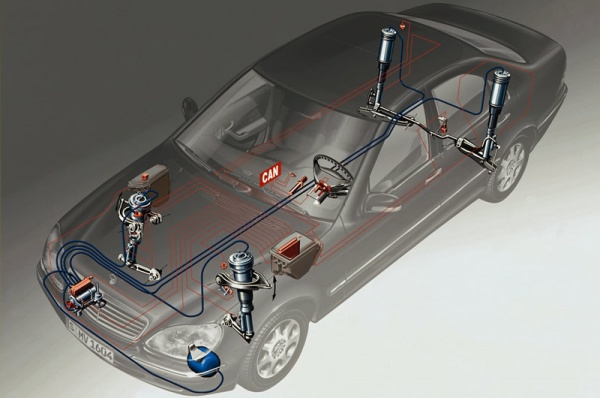
Features - Airmatic
- Level control both manual and speed sensitive.
- Electronic level control which maintains a constant even level at the front and rear axles according to the driving and vehicle load conditions.
- When the vehicle is stationary the level is readjusted if there is a difference of more than +/- 10mm after a door or the trunk lid is opened.
- While driving the level is readjusted if there is a difference of more than +/- 20mm. The level is adjusted to +/- 10 mm every 15 minutes.
- Active Damping System (ADS) which changes the damping forces according to the road conditions and the driver's driving style. The road conditions are determined by vertical acceleration sensors in the body of the vehicle. The horizontal acceleration is determined by measuring the vehicle speed and turn angle.
Advantages - Airmatic
Higher level of driving safety and ride comfort due to:
- Adapting damping to road conditions and driving style.
- Low location of centre of gravity as vehicle lowers above 70KPH.
- Low aerodynamic drag and fuel consumption as vehicle lowers above 70KPH.
- Less tendency for vehicle to lift at speed.
Individual adaptation due to:
- Raising vehicle level for poor road surfaces and when negotiating driveways.
- Two possible damping levels for comfort or sport driving styles in vehicles produced up to 08/99.
- Three possible damping levels for comfort, sport or extreme sport driving styles in vehicles produced after 09/99.
Driver information due to:
- Vehicle level displayed by indicator lamps and switches.
- Warning messages in multi-function display if vehicle is too low.
Input Functions - Airmatic
The Airmatic pneumatic system is controlled via the vehicle's electric/electronic components and the CAN Bus and receives input signals from:
- ESP control module
- Engine control module
- Transmission control module
- Instrument cluster
- Steering angle sensor
- ADS comfort and sport switch
- Level adjustment switch
- Three body accelerometers
- Two front axle level sensors
- One rear axle level sensor
- One Airmatic pressure sensor
Output Functions - Airmatic
The Airmatic input signals are converted in the Airmatic control module to output signals for the following components:
- Four Level control valves
- One main reservoir charge valve
- Four ADS damper valves
- Multi-function display
- Switch indicator lamps
- Air compressor
Adaptive Damping System (ADS)
The switch with the indicator lamps is located in the upper part of the center console.
The ADS automatically selects the optimum damping for the respective driving conditions. At the same time the suspension is set to either sporty or regular.
The suspension tuning is set according to:
- Your driving style
- Road surface conditions
- Your choice of suspension style, "sport" or "convenience", which you select using the damping switch.
The following suspension styles are available:
- "Convenience" - both indicator lamps (1) are off.
- "Sports 1" - one indicator lamp (1) is on.
- "Sports 2" - both indicator lamps (1) are on.
The selected suspension style is stored in memory, even after the SmartKey is removed from the starter switch.
Level control system
The following vehicle level settings can be selected when the vehicle is stationary:
- "Normal" - for driving on normal roads. The indicator lamp (1) is off.
- "Raised" - for driving on rough roads or with snow chains. The indicator lamp (1) is on.
Select the "Raised" level setting only when required by current driving conditions. Otherwise the fuel consumption may increase and handling may be impaired.
The vehicle chassis ride height is raised or lowered according to the selected level setting and to the vehicle speed (these height adjustments are so small that you may not notice any change):
- With increasing speed, ride height is reduced by up to approximately 3/4 in (20 mm).
- With decreasing speed, the ride height is again raised to the selected vehicle level.
The selected vehicle level setting remains stored in memory even if the engine is turned off and restarted. However, the vehicle lowers to regular level when you exceed a speed of 75 mph (120 km/h) or maintain a speed of between 50 mph (80 km/h) and 75 mph (120 km/h) for more than 5 minutes.
This can be used to raise the vehicle level by 25 mm (20 mm USA). The raised level switch position is indicated by the red indicator lamp (1) in the switch. In addition, the multifunction display in the instrument cluster displays: "AIRMATIC VEHICLE RISING".
As long as the multifunction display in the instrument cluster shows the message: "AIRMATIC VEHICLE RISING", the desired vehicle level has not yet been reached. If the raising of the vehicle is cancelled due to the driving speed, the instrument cluster displays the following message for approx. 10s: "AIRMATIC LEVEL SETTING CANCELLED". If the vehicle is raised several times in quick succession, it may happen that the air compressor shuts down temporarily in order to prevent an overload. The raising sequence will then take an unusually long time.
Components
AIRmatic, location of electrical/electronic components:
- A9/1 - AIRmatic compressor unit
- A1p13 - Multifunction display
- B7 - AIRmatic pressure sensor
- B22/3 - Rear axle level sensor
- B22/8 - Left front level sensor
- B22/9 - Right front level sensor
- B24/3 - Left front body acceleration sensor
- B24/4 - Right front body acceleration sensor
- B24/6 - Right rear body acceleration sensor
- K40/7 - Right front fuse and relay module
- kO - AIRmatic compressor relay
- N49 - Steering angle sensor
- N51 - AIRmatic with ADS control module
- N72/1s2 - Level control switch
- N72/1s3 - Comfort and sport switch
- S9/1 - Stop lamp switch
- X11/4 - Data link connector
- Y36/6 - Level control valve unit
- Y51 - Left front axle damping valve unit
- Y52 - Right front axle damping valve unit
- Y53 - Left rear axle damping valve unit
- Y54 - Right rear axle damping valve unit
AIRmatic, location of pneumatic/hydraulic components:
- 40 - Front spring strut
- 41 - Rear spring strut
- 42 - AIRmatic central reservoir
- A9/1 - AIRmatic compressor unit
- Y36/6 - Level control valve unit
- Y51 - Left front axle damping valve unit
- Y52 - Right front axle damping valve unit
- Y53 - Left rear axle damping valve unit
- Y54 - Right rear axle damping valve unit
AIRmatic with ADS control module (N51)
AIRmatic with ADS control module, task: To execute all control functions of ADS and AIRmatic. Air suspension control unit is located in left fuse box.
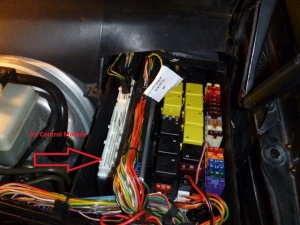
|
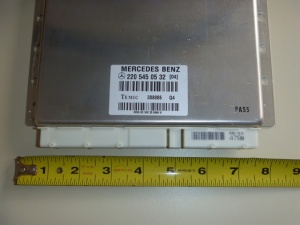
|
Level control valve unit (Y36/6)
Damping valve unit (Y51, Y52, Y53, Y54)
Damping valve, task: adapts the damping force to the driving style and road condition.
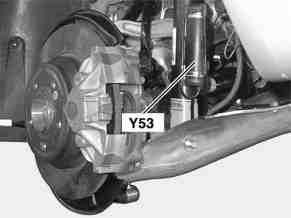 |
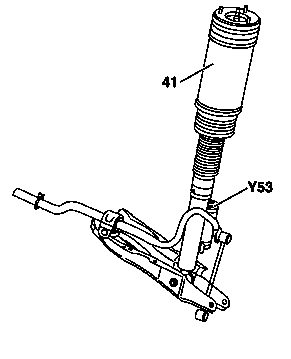 |
 |
Multifunction display (A1p13)
Various messages concerning the AIRmatic and ADS are shown in the multifunction display in the instrument cluster and in the comfort and sport and level adjustment switches.
AIRMATIC VISIT WORKSHOP!
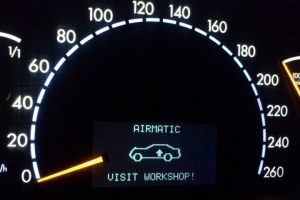
In the event of electrical faults in the AIRmatic or ADS system, the following message appears on the multifunction display in the instrument cluster: "AIRMATIC VISIT WORKSHOP!". The fault is stored in the ADS suspension control module and can be read out using the diagnosis tool.
Limp-home function A malfunction in the adaptive damping system causes the ADS to shut down. The suspension is switched to the hardest setting. In the event of a fault in the suspension system or in the level adjustment system, the vehicle attempts to maintain the set level. Manual and automatic level adjustments are no longer possible.
AIRMATIC STOP, CAR TOO LOW!
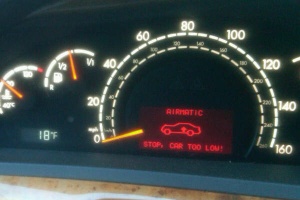
If the vehicle level at the front axle is more than 50 mm (60 mm USA), or at the rear axle more than 60 mm (70 mm USA) below the normal level, the multifunction display in the instrument cluster displays the warning: "AIRMATIC STOP, CAR TOO LOW!". The display disappears again when the level has risen back to 48 mm or 58 mm (58 mm or 68 mm USA) respectively below the normal level.
Emergency Procedure - Airmatic
Emergency procedure refer to: http://www.benzworld.org/forums/w220-s-class/1547183-how-fix-w220-airmatic-strut-6-a.html
Issues - Airmatic
With thanks and acknowledgement to the authors with some editorial licence.
Issues by eric242340 - Airmatic
Now, the rear suspension, in my opinion, almost never develops air leaks. The real problems come with the following:
- 1. Compressor failure or partial failure.
- 2. Valve block on top of compressor failure (very common).
- 3. Valve failure on rear suspension strut (often indicated by DAS) but wrongly.
- 4. Air leak on front suspension tops (for which there is a modification).
- If it is 1 then new compressor.
- If it is 2 then new valve block.
- If it is 3 then new strut (but uncommon).
- If it is 4 then do the modification.
But however you look at this, if the garage does not have Star Diagnostics and a Mechanic who can interpret the values both in sensor voltage and other tests then don't waste your time and money.
With thanks to BenzWorld Member eric242340 refer to: http://www.benzworld.org/forums/w220-s-class/1329314-s-class-airmatic-woes-yes-again.html
Issues by danielsand - Airmatic
The Airmatic is NOT terribly complicated system. Don't be scared of it, and go slow and systematic in troubleshooting it. How does it work? Simple. The electricity is supplied to the pump via the (hopefully!) Hella relay (passenger side fuse box - US config), the relay is the first one next to the three 40 amp fuses. First fuse next to the relay is a smog pump fuse (forget about it), and the middle one is #32 that protects the Airmatic circuit. Check that first. (and yank both pieces OUT BEFORE you start working on Airmatic!!)
Once the relay sends the juice to the pump, the pump comes alive. The air comes in through the black hose (that has the filter in-line), and then the air is supplied to the valve (nothing mysterious there, just a "crossover" valve that directs the air to the struts that need it, based on the input from the sensors). If the pump is working, but not sucking, either the filter is blocked (unlikely), or the hose is kinked, damaged or obstructed.
If all connections of the white PVC lines on the valve (and the main line that goes from the pump to the valve) are holding air, the car HAS TO rise. If it doesn't, there is a leak somewhere that is not easy to detect. Once the air is distributed by the valve to the struts, it goes to the top of the struts and inflates the air bags inside the struts. If the pump is working, and there is no air reaching the valve, the main PVC line is kinked, broken, cracked, or obstructed.
If the air (with correct pressure) is reaching the valve, but it's not supplied to the struts, the valve has a problem (electrical connections damaged, dirty, not connected, or valve itself going bad). If the valve is doing its job, and the struts are not being inflated, then the struts have a LEAK (a big one!).
Now, when you removed the Airmatic pump, how did you lift the car, and more importantly, how did you LOWER it back down? If you read EVERYTHING about Airmatic, you will find out that overextending the strut can cause the leak on the strut under the bellows, and more importantly, once lowered down, you HAVE TO inflate the struts BEFORE the full weight of the car is on deflated struts!
When I replaced my pump, I used TWO jacks. One to lift the body, and one under the swingarm to lift the wheel without over extending the strut (I lifted only the passenger side). Passenger side strut was never overextended, and after the replacement was done, I lowered the car until the wheel touched the ground (still on the jacks, without the full weight of the car on the wheel), and THEN I engaged the pump, and let it run for few minutes. I didn't have to, because my strut was not completely empty (valve prevents the complete loss of air), but I played it safe.
Bottom line, the Airmatic bellows never became detached, air never escaped, and after the pump was bolted and operated, I sprayed soapy water on all PVC connections, and detected no leaks.
So, read the BenzWorld Encyclopedia and learn about all components of the Airmatic system, and go slow. Once you learn how it all operates, and what each part of the system is supposed to do, you will find the fault, no doubt. Good luck!
With thanks to BenzWorld Member danielsand refer to: http://www.benzworld.org/forums/w220-s-class/1557414-2001-s430-airmatic-not-rising-please-3.html
Issues by nicedeals.co.uk - Airmatic
If the air suspension on your M-B S Class has dropped on all four wheels and the diagnostic test is pointing towards an Airmatic pump fault, you will most likely need to replace it. The airmatic pump on the W220 model is located under the driver side front wing splashguard. Remove the alloy wheel and remove the nuts and clips holding the splashguard in place.
If the drop is limited to one side only, the fault will most likely be limited to that particular shock absorber air bellow unit.
http://www.nicedeals.co.uk/car/diy/8-mercedes/2509-mercedes-w220-s-class-airmatic-pump-replacement
Level Control and Notes - Airmatic
Edit required.
http://www.benzworld.org/forums/w220-s-class/1656870-airmatic-rear-end-drooping-intermittently.html
http://danirangelov.blogspot.com/2013/09/mercedes-w220-s-class-airmatic-level.html
http://www.benzworld.org/forums/w220-s-class/1467695-airmatic-strut-epoxy-fix-3.html
DIY Procedures - Airmatic
Edit required.
DIY Diagnosis - Airmatic
Diagnosis with soap water. http://www.benzworld.org/forums/w220-s-class/2242706-airmatic-winter-problem-2.html
http://forums.mercedesclub.org.uk/showthread.php?t=110643
C1324-001 Fault in component Y53y1 (Left rear solenoid valve 1) in assembly Y53 (left rear axle damping valve unit)
C1325-001 Fault in component Y53y2 (Left rear solenoid valve 2) in assembly Y53 (left rear axle damping valve unit)
DIY Valve - Airmatic
http://www.benzworld.org/forums/w220-s-class/1656870-airmatic-rear-end-drooping-intermittently.html
DIY Pump - Airmatic
DIY Relay - Airmatic
DIY ECU - Airmatic
DIY Height Sensors - Airmatic
DIY Struts - Airmatic
Replacements - Airmatic
Arnott Rebuilds
Arnott rebuilts cost $575 but they only install new rubber air bladders and not the shock piston seals or gas charge. But Arnott rebuilt units DO allow you to maintain the selective electronic damping, ie the button on the center dash that firms up or softens the ride.
Arnott New
Arnott NEW units cost $624. BUT with all new units you lose the electronic damping. While the new Arnott units allow you to plug in the original wire harness from the car. It simply fools the computer to thinking the selective damping is functioning. In reality it's not and the shock has mechanical damping instead.
Bilstein OE
If Bilstein is indeed the OEM manufacturer for M-B and a brand new strut from Bilstein costing $700 would come with entirely new components you wouldn't lose any original functionality or comfort.
Replacement Tutorials - Airmatic
http://www.bilsteinus.com/fileadmin/user_upload/user_upload_us/pdfs/E4-WM5-Y328A00_01.pdf (EN/DE)
http://info.bilsteinus.com/mercedes/ (videos)
